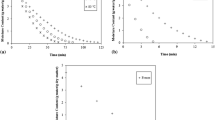Abstract
In this study, some physical properties (principal dimensions, mean diameters, sphericity, area, density and electrical conductivity) of split chickpea were measured as function of soaking time (up to 360 min) and temperature (25-65 °C). Initially, the water absorption rate was high and then it showed a progressive decrease at all temperatures, whereas solid loss exhibited a power function of temperature (P < 0.05). The Peleg model was predicted well the kinetic of split chickpea soaking. No significant difference (P < 0.05) was observed in Peleg rate constant (K1) and Peleg capacity constant (K2) at all temperatures except for K1 at 25 °C. The discrepancy for K1 was in relation to permeability characteristics of split chickpea at temperature of 25 °C. As temperature increased from 25 to 65 °C, the K1 value decreased from 0.04620 to 0.00945 g h−1, whereas the K2 value increased from 0.08597 to 0.11320 g−1. Plot for K1 exhibited a slope changes around 45 °C corresponding to gelatinization temperature of split chickpeas. The effect of temperature and time on physical properties of split chickpea during soaking was monitored by regression equations. It was concluded that physical properties of split chickpea affected by its water absorption especially at higher temperatures.



Similar content being viewed by others
References
Abu-Ghannam N,, McKenna B (1997) The application of Peleg’s equation to model water absorption during the soaking of red kidney beans (Phaseolus vulgaris L.). J Food Eng 32:391–401
AOAC (1980) Official methods of analysis, 13th edn. Association of Official Analytical Chemists, Washington, DC
Baryeh ED (2002) Physical properties of millet. J Food Eng 51:39–46
Bello M, Tolabo MP, Suarez C (2004) Factors affecting water uptake of rice grain during soaking. LWT Food Sci Technol 37 811–816.
Cunningham SE, McMinn WAM, Magee TRA, Richardson PS (2007) Modeling water absorption of pasta during soaking. J Food Eng 82:600–607
Dursun E, Dursun I (2005) Some physical properties of caper seed. Biosyst Eng 92 237–245
Elbert G, Tolaba MP, Suarez C (2001) Model application: hydration and gelatinization during rice parboiling. Dry Technol 19 571–581.
Food and Agriculture Organization (2011) http://www.faostat.fao.org.
Fosgate GT, Petzer IM, Karzis J (2013) Sensitivity and specificity of a hand-held milk electrical conductivity meter compared to the California mastitis test for mastitis in dairy cattle. Vet J 196:98–102
Hung TV, Liu LH, Black RG, Trewhella MA (1993) Water absorption in chickpea (C. arietinum) and field pea (P. sativum) cultivars using the Peleg model. J Food Sci 58:848–852
Jideani VA, Mpotokwana SM (2009) Modeling of water absorption of Botswana Bambara varieties using peleg’s equation. J Food Eng 92:182–188
Jukantil AK, Gaurl PM, Gowada CLL, Chibbar RN (2012) Nutritional Quality and Health Benefits of chickpea (Cicer arietinum L.). Br J Nutr 108:11–26
Kashiri M, Kashaninejad M, Aghajani N (2010) Modeling water absorption of sorghum during soaking. Lat Am Appl Res 40:383–388
Konak M, Carman K, Aydin C (2002) Physical properties chickpea seeds. Biosyst Eng 82, 73–78.
Maharaj V,, Sankat CK (2000) The rehydration characteristics and quality of dehydrated dasheen leaves. Can Agric Eng 42:81–85
Milani E, Razavi SMA, Koocheki A, Nikzadeh V, Vahedi N, MoeinFard M, GholamhosseinPour A (2007) Moisture dependent physical properties of cucurbit seeds. Intensiv Agric 21(2):7–168
SMA R, Farahmandfar R (2008) Effect of hulling and milling on the physical properties of rice grains. Intensiv Agric 22:353–359
Resio AC, Aguerre RJ, Suarez C (2006) Hydration kinetics of amaranth grain. J Food Eng 72:247–253
Sanchez-Vioque R, Clemente A, Vioque J, Bautista J, Millan F (1999) Protein isolates from chickpea (cicer arietinum L.): chemical composition, functional properties and protein characterization. Food Chem 64:237–243
Sarang S, Sastry SK, Knipe L (2008) Electrical conductivity of fruits and meats during ohmic heating. J Food Eng 87:351–356
Sayar S, Turhan M, Gunasekaran S (2001) Analysis of chickpea soaking by simultaneous water transfer and water-starch reaction. J Food Eng 50:91–98
Singh N, Kaur SH, Isono N, Noda T (2010) Genotypic diversity in physico-chemical, pasting and gel textural properties of chickpea (cicer arietinum L.). Food Chem 122:65–73
Thushan Sanjeewa WG, Janitha PD, Pietrasik Z, Shand PJ (2010) Characterization of chickpea (cicer arietinum L.) flours and application in low-fat pork bologna as a model system. Food Res Int 43:617–626
Turhan M, Sayar S, Gunasekaran S (2002) Application of peleg model to study water absorption in chickpea during soaking. J Food Eng 53:153–159
Uebersax Mark A (2006) Dry edible beans: indigenous staple and healthy cuisine. The Forum on Public Policy
Wardhani DH, Vazguez JA, Pandiella SS (2008) Kinetics of daidzin and genistin transformations and water absorption during soybean soaking at different temperatures. Food Chem 111:13–19
Yadav BK, Jindal VK (2007) Water uptake and solid loss during cooking of milled rice (Oryza sativa L.) in relation to its physicochemical properties. J Food Eng 80:46–54
Yildirim A, Öner MD, Bayram M (2010) Modeling of Water Absorption of Ultrasound Applied Chickpeas (Cicer arietinum L.) using Peleg’s Equation. Journal of Agricultural Sciences 16 278–286
Author information
Authors and Affiliations
Corresponding author
Rights and permissions
About this article
Cite this article
Johnny, S., Razavi, S.M.A. & Khodaei, D. Hydration kinetics and physical properties of split chickpea as affected by soaking temperature and time. J Food Sci Technol 52, 8377–8382 (2015). https://doi.org/10.1007/s13197-015-1893-1
Revised:
Accepted:
Published:
Issue Date:
DOI: https://doi.org/10.1007/s13197-015-1893-1




